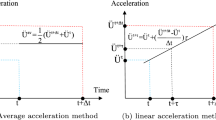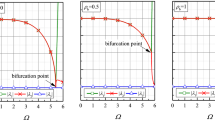Abstract
This report considers the effect of adding a simple time filter to the fully implicit or backward Euler method. The approach is modular and requires the addition of only one line of additional code. Error estimation and variable time step are straightforward and the individual effect of each step is conceptually clear. The backward Euler method with a curvature reducing time filter induces an equivalent 2-step, second order, A-stable, linear multistep method.








Similar content being viewed by others
Notes
This notation convention will be used through out the text.
References
Asselin, R.A.: Frequency filter for time integration. Mon. Weather Rev. 100, 487–490 (1972)
Becker, J.: A second order backward difference method with variable steps for a parabolic problem. BIT 38, 644–662 (1998)
Corduneanu, C.: Almost Periodic Functions. Chelsea, New York (1989)
Dahlquist, G.: Positive functions and some applications to stability questions for numerical methods. In: de Boor, C., Golub, G. (eds.) Recent Advances in Numerical Analysis, pp. 1–29. Academic Press, London (1978)
Dahlquist, G.: Some properties of linear multistep and one-leg methods for ordinary differential equations. In: Conference Proceeding, 1979 SIGNUM Meeting on Numerical ODE’s, Champaign, Ill. http://cds.cern.ch/record/1069163/files/CM-P00069449.pdf (1979)
Dahlquist, G., Liniger, W., Nevanlinna, O.: Stability of two step methods for variable integration steps. SIAM J. Numer. Anal. 20, 1071–1085 (1983)
Durran, D.R.: The third order Adams–Bashforth method: an attractive alternative to leapfrog time differencing. Mon. Weather Rev. 119(3), 702–720 (1991)
Emmrich, E.: Stability and error of the variable two-step BDF for semilinear parabolic problems. J. Appl. Math. Comput. 19, 33–55 (2005)
Griffiths, D.F., Higham, D.J.: Numerical Methods for Ordinary Differential Equations. Springer, London (2010)
Hairer, E., Wanner, G., Norsett, S.P.: Solving Ordinary Differential Equations, I, Nonstiff Problems. Springer, Berlin (1991)
Kalnay, E.: Atmospheric Modeling, Data Assimilation and Predictability. Cambridge Univ. Press, Cambridge (2003)
Lorenz, E.N.: Deterministic nonperiodic flow. J. Atmos. Sci. 20, 130–141 (1963)
Li, Y., Trenchea, C.: Analysis of time filters used with the leapfrog scheme. Technical report. http://www.mathematics.pitt.edu/research/technical-reports (2015)
Najman, L.: Modern Approaches to Discrete Curvature, Lecture Notes in Mathematics. Springer, Berlin (2017)
Nevanlinna, O.: Some remarks on variable step integration. Z. Angew. Math. Mech. 64, 315–316 (1984)
Robert, A.: The integration of a spectral model of the atmosphere by the implicit method. In: Proceedings of WMO/IUGG Symposium on NWP, pp. 19–24. Japan Meteorological Soc., Tokyo, Japan (1969)
Sussman, M.: A stability example. Technical report. http://www.mathematics.pitt.edu/sites/default/files/research-pdfs/stability.pdf (2010)
Williams, P.D.: A proposed modification to the Robert–Asselin time filter. Mon. Weather Rev. 137, 2538–2546 (2009)
Williams, P.D.: Achieving seventh-order amplitude accuracy in leapfrog integration. Mon. Weather Rev. 141(9), 3037–3051 (2013)
Williams, P.D.: The RAW filter: an improvement to the Robert–Asselin filter in semi-implicit integrations. Mon. Weather Rev. 139, 1996–2007 (2011)
Author information
Authors and Affiliations
Corresponding author
Additional information
Communicated by Antonella Zanna Munthe-Kaas.
Partially supported by NSF Grant DMS 1522574. Partially supported by NSF Grant DMS 1522267 and NSF Grant CBET-CDS&E 1609120.
Rights and permissions
About this article
Cite this article
Guzel, A., Layton, W. Time filters increase accuracy of the fully implicit method. Bit Numer Math 58, 301–315 (2018). https://doi.org/10.1007/s10543-018-0695-z
Received:
Accepted:
Published:
Issue Date:
DOI: https://doi.org/10.1007/s10543-018-0695-z




